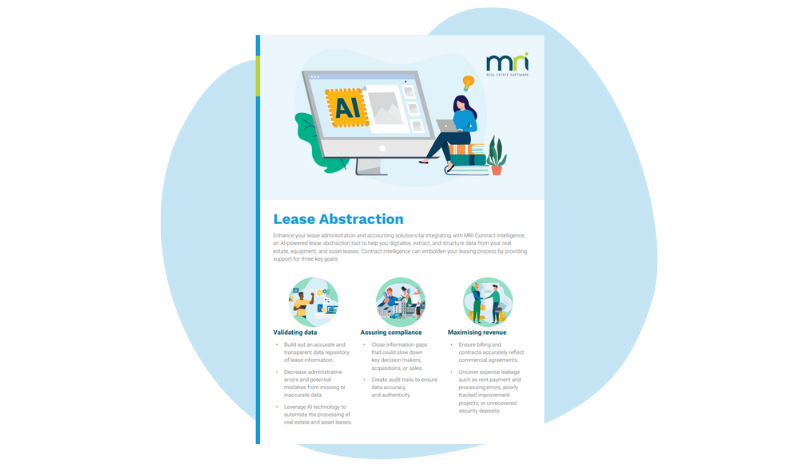Creating a business case for lease management software
In the highly competitive world of property management, staying on top of your portfolio is the key to success. However, juggling leases can be a complex task of documents, deadlines and specifics that often challenge even the most experienced lease managers. With the shift to IFRS 16 and other global accounting standards, the demand for structured lease management has grown. For numerous organisations, adopting lease management software is the clear path to organised lease oversight.
This comprehensive guide will walk you through crafting a compelling business case and equipping you with the necessary tools to advocate for a lease management system in your company. From defining core objectives to presenting compelling figures that will win stakeholders over, this guide focuses not just on the ‘why,’ but also the ‘how.’
Table of contents:
- Objectives of implementing lease management software
- Why develop a business case for lease management software?
- How to craft a strong business case
- Guide to persuading your stakeholders
- Why replace your current lease management process?
- How we can help
Objectives of implementing lease management software
The initial step in building a business case is understanding why you are building it in the first place. The primary objectives for instituting a lease management software can be numerous, from regulatory compliance to operational efficiency and beyond. Lease management software aims to streamline complex lease accounting processes and provide a centralised, transparent view of your lease portfolio. This section deep dives into what successful implementation can achieve.
Understanding the core goals
Before you start drafting your business case, it’s crucial to have a clear understanding of the key benefits that you aim to achieve and that your business case is in line with the overarching goals of your organisation. Here are some potential objectives that you may wish to consider:
- Eliminating risks associated with missed deadlines and critical dates
- Avoiding financial leakages and penalties by implementing robust processes and controls.
- Ensuring compliance with lease accounting standards to avoid any regulatory issues.
- Reducing the administrative burden on your team to increase operational efficiency.
- Enhancing the accuracy of financial reporting to provide stakeholders with reliable information.
- Streamlining lease abstraction and management processes to improve agility and responsiveness.
- Centralising data to derive actionable insights and support strategic decision-making across the organisation.
Why develop a business case for lease management software?
A business case serves as a decision-making tool, enabling stakeholders to comprehend the value proposition of adopting a lease management software solution. In this section, we’ll explore why a business case is not just an afterthought but a central piece in the puzzle of meaningful change.
The importance of a structured argument
Building a business case isn’t merely about advocating for a product, it’s about building a structured argument that links the software solution to your organisation’s strategic objectives, financial goals and risk mitigation strategy. Without a business case, you risk presenting a half-baked or misaligned proposition that can hinder the software’s adoption and places buy-in from your decision-maker in jeopardy.
How to craft a strong business case
Now that you understand the importance of presenting a strong argument, it’s now time to dive into the strategic journey of building a business case. This involves creating a well-defined structure for your document and pinpointing the key stakeholders it will engage. This section will lay the groundwork for the blueprint you’ll use to present your case effectively.
Business case essentials
Consider the following elements essential to any business case:
- A clear executive summary and purpose statement.
- A thorough description of the current state of your lease management.
- The future state and envisioned benefits of the software.
- A detailed analysis of the immediate and long-term costs.
- The projected return on investment (ROI).
- The risks associated with implementation.
- A high-level project plan.
Guide to persuading your stakeholders
A compelling business case is just the start. Effectively communicating and engaging with stakeholders is equally crucial. This segment offers strategies to present your business case in a way that connects with diverse audiences.
Tailor your presentation
Stakeholders each have their priorities and understanding their perspectives is vital. Tailor your case by focusing on benefits that matter most to them, whether that’s:
- Cost savings for the finance team
- Operational efficiencies for the operations team
- Risk mitigation for the legal team.
Anticipate objections
No business case is immune from objections. Pre-emptively address potential concerns, such as data security, software usability or ROI calculation methodologies.
Harnessing the power of storytelling
Numbers are important, but they’re more effective when woven into a compelling narrative. Tell a story with your business case. Use real-world examples of how the software has helped other organisations.
Keep it succinct
As a workforce, our time continues to be stretched across several competing priorities. The same can be said for our leaders making business decisions. To ensure a complete review of the business case is completed, we recommended a short and succinct business case, no more than two-pages long.
Why replace your current lease management process?
Before you conclude your business case, it’s important to shine a spotlight on the deficiencies of your current lease management process. This chapter ventures into the reasons why change is not only beneficial but necessary.
Assessing the inefficiencies
What pain points are inherent to your current lease management process? Common issues include lack of visibility into critical dates, challenges in lease non-financial data management or sub-optimal lease amendments or terminations.
Understanding the long-term costs of inaction
Failing to address these inefficiencies has long-term costs. These could include missed savings opportunities, an inability to scale or the potential for non-compliance penalties and increased audit exposure.
Incorporate these insights into your business case to create a compelling argument for change. By walking you through the objectives, key components and persuasive strategies, this guide empowers you to create a business case that isn’t just presented—it’s considered and converted into action.
How the team at MRI Software can help
Creating a compelling business case for lease management software requires careful planning, thorough research and clear communication. But you don’t have to embark on this journey alone.
Our team is here to provide all the support you need. From offering detailed information on our software’s unique capabilities to sharing relevant case studies demonstrating its real-world impact, we’re dedicated to helping you build an ironclad argument for this strategic investment.
To learn more, please contact us today.
Lease Management Software
Lease management software for complete and easy control over complex lease portfolios.
Get a demo
Manage your leases with confidence
Whether you want to stay up-to-date with current compliance standards, understand the costs associated with managing your workspace, or partner with a services team to outsource time-consuming lease administration tasks, MRI can assist you with lease…

